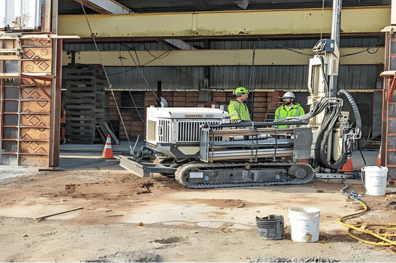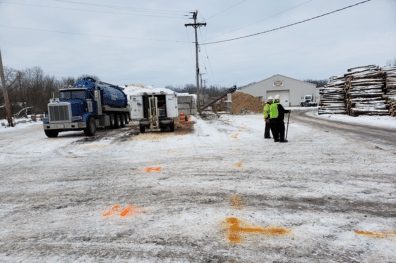ORIN conducted direct injection treatment to target groundwater contaminated with Alachlor using BAM, a pyrolized cellulosic material. Previously, an excavation was completed to try and remove the contaminated soil and the source of groundwater contamination. After little effect at reducing the concentrations BAM was selected. First, a treatability test was conducted to prove BAM could reduce alachlor at the site. With successful results field scale treatment was applied. Twelve injection points were utilized for treating a 1,190-ft2 area.
The Challenge
The site presented specific challenges:
- High Alachlor concentrations: 12,000 µg/L
- Failed previous excavation attempt
- Persistent groundwater contamination
- 1,190-ft² treatment area
- Need for proven solution
The Solution: Strategic Approach
The team implemented a two-phase strategy:
- Validation Phase:
- Initial treatability testing
- BAM effectiveness verification
- Treatment protocol development
- Success criteria establishment
- Implementation Phase:
- 12 strategic injection points
- BAM material deployment
- Rapid response monitoring
- Long-term effectiveness tracking
Remarkable Results Timeline
The treatment showed impressive progress:
24 Hours Post-Treatment:
- Initial concentration: 12,000 µg/L
- Reduced to: 6,000 µg/L
- Achievement: 50% reduction
40 Days Post-Treatment:
- Final concentration: significantly reduced
- Total reduction: 97.9%
- Exceeded expectations
- Validated treatment approach
Key Success Factors
Several elements contributed to the exceptional outcome:
- Comprehensive treatability testing
- Strategic injection point placement
- Optimal BAM deployment
- Rapid monitoring program
- Long-term effectiveness tracking
Innovation Highlights
The project demonstrated several advantages:
- Superior to traditional excavation
- Rapid initial response
- Continued improvement over time
- Minimal site disruption
- Proven effectiveness
Practical Applications
This success provides solutions for:
- Agricultural chemical contamination
- Failed remediation sites
- Groundwater treatment
- Complex contamination scenarios
- Sites requiring rapid response
This case study demonstrates how innovative technology can succeed where traditional methods fall short, providing a new standard for agricultural chemical remediation.



